-

新人教版高中英语选修2Unit 2 Reading and thinking教学设计
Her tutor told her to acknowledge __________ other people had said if she cited their ideas, and advised her _______(read) lots of information in order to form __________wise opinion of her own.Now halfway __________ her exchange year, Xie Lei felt much more at home in the UK. She said __________ (engage) in British culture had helped and that she had been__________ (involve) in social activities. She also said while learning about business, she was acting as a cultural messenger __________(build) a bridge between the two countries. keys:Xie Lei, a 19yearold Chinese student, said goodbye to her family and friends in China and boarded (board) a plane for London six months ago in order to get a business qualification. She was ambitious(ambition) to set up a business after graduation. It was the first time that she had left (leave) home.At first, Xie Lei had to adapt to life in a different country. She chose to live with a host family, who can help with her adaptation (adapt) to the new culture. When she missed home, she felt comforted (comfort) to have a second family. Also Xie Lei had to satisfy academic requirements. Her tutor told her to acknowledge what other people had said if she cited their ideas, and advised her to read lots of information in order to form a wise opinion of her own.Now halfway through her exchange year, Xie Lei felt much more at home in the UK. She said engaging (engage) in British culture had helped and that she had been involved (involve) in social activities. She also said while learning about business, she was acting as a cultural messenger building a bridge between the two countries.

新人教版高中英语选修2Unit 3 Reading for writing教学设计
The theme of this part is to write an article about healthy diet. Through reading and writing activities, students can accumulate knowledge about healthy diet, deepen their understanding of the theme of healthy diet, and reflect on their own eating habits. This text describes the basic principles of healthy diet. The author uses data analysis, definition, comparison, examples and other methods. It also provides a demonstration of the use of conjunctions, which provides important information reference for students to complete the next collaborative task, writing skills, vivid language materials and expressions.1. Teach Ss to learn and skillfully use the new words learned from the text.2. Develop students’ ability to understand, extract and summarize information.3. Guide students to understand the theme of healthy diet and reflect on their own eating habits.4. To guide students to analyze and understand the reading discourse from the aspects of theme content, writing structure, language expression, etc., 5. Enable Ss to write in combination with relevant topics and opinions, and to talk about their eating habits.1. Guide students to analyze and understand the reading discourse from the aspects of theme content, writing structure, language expression, etc.2. Enable them to write in combination with relevant topics and opinions, and to talk about their eating habits.3. Guide the students to use the cohesive words correctly, strengthen the textual cohesion, and make the expression fluent and the thinking clear.Step1: Warming upbrainstorm some healthy eating habits.1.Eat slowly.2.Don’t eat too much fat or sugar.3.Eat healthy food.4.Have a balanced diet.Step2: Read the passage and then sum up the main idea of each paragraph.

新人教版高中英语选修2Unit 2 Reading for writing教学设计
The theme of this section is to express people's views on studying abroad. With the continuous development of Chinese economic construction, especially the general improvement of people's living standards, the number of Chinese students studying abroad at their own expense is on the rise. Many students and parents turn their attention to the world and regard studying abroad as an effective way to improve their quality, broaden their horizons and master the world's advanced scientific knowledge, which is very important for the fever of going abroad. Studying abroad is also an important decision made by a family for their children. Therefore, it is of great social significance to discuss this issue. The theme of this section is the column discussion in the newspaper: the advantages and disadvantages of studying abroad. The discourse is about two parents' contribution letters on this issue. They respectively express their own positions. One thinks that the disadvantages outweigh the advantages, and the other thinks that the advantages outweigh the disadvantages. The two parents' arguments are well founded and logical. It is worth noting that the two authors do not express their views on studying abroad from an individual point of view, but from a national or even global point of view. These two articles have the characteristics of both letters and argumentative essays1.Guide the students to read these two articles, and understand the author's point of view and argument ideas2.Help the students to summarize the structure and writing methods of argumentative writing, and guides students to correctly understand the advantages and disadvantages of studying abroad3.Cultivate students' ability to analyze problems objectively, comprehensively and deeply

新人教版高中英语选修2Unit 2 Using langauge-Listening教学设计
? B: Absolutely! Getting involved with Chinese cultural activities there definitely helped a lot. I got to practice my Chinese on a daily basis, and I could learn how native Chinese speakers spoke.? A: What do you feel is your biggest achievement?? B: Learning Chinese characters! I have learnt about 1,500 so far. When I first started, I didn't think it was even going to be possible to learn so many, but now I find that I can read signs, menus, and even some easy newspaper articles.? A: What are you most keen on?? B: I've really become keen on learning more about the Chinese culture, in particular Chinese calligraphy. As I have learnt Chinese characters, I have developed a great appreciation for their meaning. I want to explore Chinese characters by learning how to write them in a more beautiful way. ? A: Finally, what do you want to say to anyone interested in learning Chinese?? I have really become keen on learning more about the Chinese culture, in particular Chinese Calligraphy. As I have learnt Chinese character, I have developed a great appreciation for their meaning. I want to explore Chinese characters by learning how to write them in a more beautiful way.? A: Finally, what do you want to say to anyone interested in learning Chinese?? B: I'd say, give it a shot! While some aspects may be difficult, it is quite rewarding and you will be happy that you tried.? A: Thanks for your time. ? B:You're welcome.

新人教版高中英语选修2Unit 3 Using langauge-Listening教学设计
1. How is Hunan cuisine somewhat different from Sichuan cuisine?The heat in Sichuan cuisine comes from chilies and Sichuan peppercorns. Human cuisine is often hotter and the heat comes from just chilies.2.What are the reasons why Hunan people like spicy food?Because they are a bold people. But many Chinese people think that hot food helps them overcome the effects of rainy or wet weather.3.Why do so many people love steamed fish head covered with chilies?People love it because the meat is quite tender and there are very few small bones.4.Why does Tingting recommend bridge tofu instead of dry pot duck with golden buns?Because bridge tofu has a lighter taste.5 .Why is red braised pork the most famous dish?Because Chairman Mao was from Hunan, and this was his favorite food.Step 5: Instruct students to make a short presentation to the class about your choice. Use the example and useful phrases below to help them.? In groups of three, discuss what types of restaurant you would like to take a foreign visitor to, and why. Then take turns role-playing taking your foreign guest to the restaurant you have chosen. One of you should act as the foreign guest, one as the Chinese host, and one as the waiter or waitress. You may start like this:? EXAMPLE? A: I really love spicy food, so what dish would you recommend?? B: I suggest Mapo tofu.? A: Really ? what's that?

新人教版高中英语选修2Unit 4 Reading for writing教学设计
假定你是英国的Jack,打算来中国旅行,请你给你的中国笔友李华写一封信,要点如下:1.你的旅行计划:北京→泰山→杭州;2.征求建议并询问他是否愿意充当你的导游。注意:1.词数80左右(开头和结尾已给出,不计入总词数);2.可以适当增加细节,以使行文连贯。参考词汇:故宫 the Forbidden City;泰山 Mount TaiDear Li Hua,I'm glad to tell you that 'm going to visit China.First,I am planning to visit Beijing,the capitalof China,where I am looking forward to enjoying the Great Wall,the Forbidden City and somebeautiful parks.Then I intend to go to visit Mount Tai in Shandong Province.I've heard that it is one ofthe most famous mountains in China and I can't wait to enjoy the amazing sunrise there.After that,I amalso going to Hangzhou.It is said that it is a beautiful modern city with breathtaking natural sights,among which the West Lake is a well- known tourist attraction.What do you think of my travel plan? Will you act as my guide? Hope to hear from you soon.

新人教版高中英语选修2Unit 4 Using langauge-Listening教学设计
The theme of the listening section is " talking about scenery and culture along a journey."The part is designed to further lead the students to understand Canadian natural geography and social environment, and integrated into the cultural contrast by mentioning the long train journey from Beijing to Moscow routes. On this basis, the part activates students related travel experience, lets the student serial dialogue, guides the student to explore further the pleasure and meaning of the long journey, and Chinese and foreign cultural comparison.The part also provides a framework for the continuation of the dialogue, which is designed to provide a framework for students to successfully complete their oral expressions, and to incorporate an important trading strategy to end the dialogue naturally.1. Help students to understand and master some common English idioms in the context, and experience the expression effect of English idioms.2. Guide the students to understand the identity of different people in the listening context, and finish the dialogue according to their own experience.3. Instruct the students to use appropriate language to express surprise and curiosity about space and place in the dialogue, and master the oral strategy of ending the dialogue naturally.1. Instruct students to grasp the key information and important details of the dialogue.2. Instruct students to conduct a similar talk on the relevant topic.

新人教版高中英语选修2Unit 5 Learning about Language教学设计
The purpose of this section of vocabulary exercises is to consolidate the key words in the first part of the reading text, let the students write the words according to the English definition, and focus on the detection of the meaning and spelling of the new words. The teaching design includes use English definition to explain words, which is conducive to improving students' interest in vocabulary learning, cultivating their sense of English language and thinking in English, and making students willing to use this method to better grasp the meaning of words, expand their vocabulary, and improve their ability of vocabulary application. Besides, the design offers more context including sentences and short passage for students to practice words flexibly.1. Guide students to understand and consolidate the meaning and usage of the vocabulary in the context, 2. Guide the students to use the unit topic vocabulary in a richer context3. Let the students sort out and accumulate the accumulated vocabulary, establishes the semantic connection between the vocabulary,4. Enable students to understand and master the vocabulary more effectivelyGuiding the Ss to use unit topic words and the sentence patterns in a richer context.Step1: Read the passage about chemical burns and fill in the blanks with the correct forms of the words in the box.

新人教版高中英语选修2Unit 5 Reading and thinking教学设计
The theme of this activity is to learn the first aid knowledge of burns. Burns is common in life, but there are some misunderstandings in manual treatment. This activity provides students with correct first aid methods, so as not to take them for granted in an emergency. This section guides students to analyze the causes of scald and help students avoid such things. From the perspective of text structure and collaborative features, the text is expository. Expository, with explanation as the main way of expression, transmits knowledge and information to readers by analyzing concepts and elaborating examples. This text arranges the information in logical order, clearly presents three parts of the content through the subtitle, accurately describes the causes, types, characteristics and first aid measures of burns, and some paragraphs use topic sentences to summarize the main idea, and the level is very clear.1. Guide students to understand the causes, types, characteristics and first aid methods of burns, through reading2. Enhance students’ ability to deal withburnss and their awareness of burns prevention3. Enable students to improve the ability to judge the types of texts accurately and to master the characteristics and writing techniques of expository texts.Guide students to understand the causes, types, characteristics and first aid methods of burns, through readingStep1: Lead in by discussing the related topic:1. What first-aid techniques do you know of ?CPR; mouth to mouth artificial respiration; the Heimlich Manoeuvre
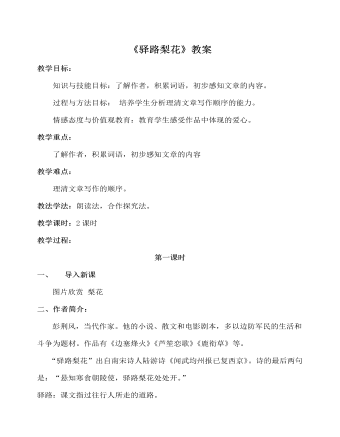
部编版语文七年级下册《驿路梨花》教案
教学目标:知识与技能目标:了解作者,积累词语,初步感知文章的内容。 过程与方法目标: 培养学生分析理清文章写作顺序的能力。 情感态度与价值观教育:教育学生感受作品中体现的爱心。教学重点:了解作者,积累词语,初步感知文章的内容教学难点:理清文章写作的顺序。教法学法:朗读法,合作探究法。教学课时:2课时教学过程:
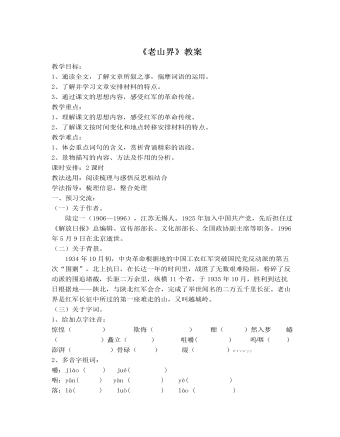
部编版语文七年级下册《老山界 》教案
用巨人矗立比喻眼前的山峰;用一口井比喻山谷,既突出了山势的险峻和连绵,又暗示了红军的艰难处境。“矗立”,形象的说明困难像拦路虎阻挡在面前,但是直立、高耸的老山界阻挡不了红军北上抗日的决心,也改变不了他们的长征必胜的信念。“极远的又是极近的,极洪大的又是极细切的,像春蚕在咀嚼桑叶,像野马在平原上奔驰,像山泉在呜咽,像波涛在澎湃。” 用了什么修辞手法?写出了作者怎样的感受?“像春蚕在咀嚼桑叶”时连续不断的细微声音,比喻战士们轻细的话语声,说明战士们被冻醒次数之多;“野马奔驰”写半夜山风之大,又喻寒风刺骨;“山泉呜咽”用拟人化手法喻山泉时断时续又暗指山势崎岖;“波涛澎湃”形容林木被风刮动的声音。人声和大自然的声音交织在一起,烘托出夜色之深,夜景之美,透露出勃勃生机,洋溢着革命乐观主义精神。非常形象地写出山景之美,表现红军战士的乐观情怀。
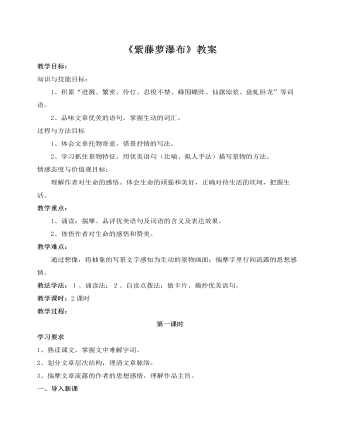
部编版语文七年级下册《紫藤萝瀑布》教案
学习要求1、熟读课文,掌握文中难解字词。2、划分文章层次结构,理清文章脉络。3、揣摩文章流露的作者的思想感情,理解作品主旨。一、导入新课紫藤萝亦称紫藤,朱藤,藤萝,豆科,羽状复叶,春季开花,蝶形花冠,青紫色,总状花序,产于我国中部,供观赏,花种子供食用。紫藤萝是瀑布吗?不是的,因为,它是很多很多的紫藤萝花组成的,因为像瀑布一样从空中垂下来,不见其发端,也不见其终极,所以文章叫《紫藤萝瀑布》。 二、作者简介宗璞,原名冯宗璞,我国当代女作家,毕业于清华大学文学系。我们学过的文章有童话《花的话》。本文背景宗璞一家,在“文化大革命”中深受迫害,“焦虑和悲痛”“一直压在”作者的心头。这篇文章写于1982年5月,当时作者的小弟身患绝症,作者非常悲痛(1982年10月小弟病逝),徘徊于庭院中,见一树盛开的紫藤萝花,睹物释怀,由花儿的自衰到盛,感悟到生的美好和生命的永恒,于是写成此文。
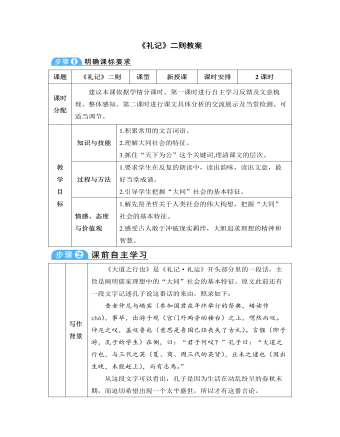
部编版语文八年级下册《礼记》二则教案
【课堂讨论,拓展延伸】1.文中“大同”社会跟陶渊明描绘的那个“世外桃源”有没有相似的地方?2.请说一段话描绘你心目中的理想社会。这是两道开放性的题目。第一题,要启发学生透过“桃源”中的生活现象来认识这个社会,例如从“黄发垂髫,并怡然自乐”中可以看出“桃源”中的老人和孩子生活极其幸福、快乐,这就是“大同”社会中“老有所终”“幼有所长”,由此还可以推知矜、寡、孤、独、废疾者这五种人同样受到全社会的关爱。第二题重在激发学生进行大胆新奇的联想和想象,营造一种畅游理想未来的热烈气氛。【把握文章主旨】仔细阅读课文,理解文章主旨。《虽有嘉肴》:本文论述了教与学的关系问题,说明了教和学是相辅相成的,是互相促进的道理。《大道之行也》:本文通过对理想中的社会特征的描述,阐明了儒家理想中的“大同”社会的基本特征,表达了作者对这个理想社会的向往,同时,也反映了我国古代劳动人民对美好生活的追求。
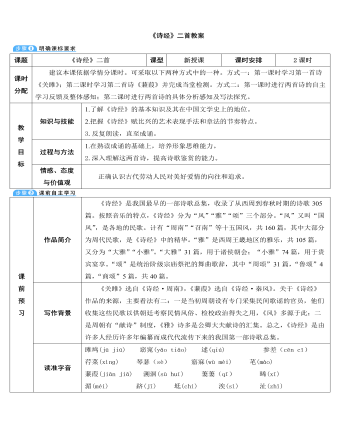
部编版语文八年级下册《诗经》两首教案
【深入研读,探究方法】《关雎》1.双声叠韵。用双声叠韵的联绵词来增强诗歌音调的和谐美和描写人物的生动性。如“窈窕”,是叠韵;“参差”,是双声;“辗转”,既是双声又是叠韵。用各类词语修饰动作,如“辗转反侧”;摹拟形象,如“窈窕淑女”;描写景物,如“参差荇菜”,无不活泼逼真、声情并茂。2.偶句入韵。这种偶韵式支配着两千多年来我国古典诗歌谐韵的形式,而且全篇三次换韵,又有虚字脚“之”字不入韵,而以虚字的前一字为韵。这种在用韵方面的参差变化,极大地增强了诗歌的节奏感和音乐美。3.起兴手法。起兴,作为《诗经》中经常使用的一种表现手法,就是触景生情,因事寄兴。一般用于一首诗的开头,先用一两句话写一下周围景物,以引起下面的诗句。比如这首诗写雎鸠鸣叫,让人联想到男女欢爱,引出下文追求淑女的诗句。
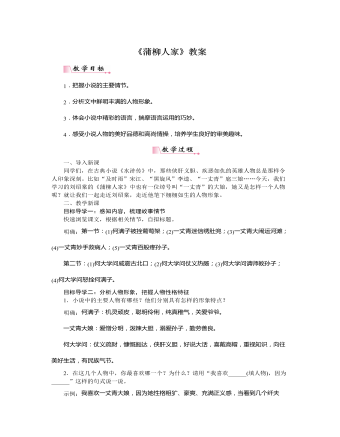
部编版语文九年级下册《蒲柳人家》教案
一、导入新课同学们,在古典小说《水浒传》中,那些侠肝义胆、疾恶如仇的英雄人物总是那样令人印象深刻。比如“及时雨”宋江、“黑旋风”李逵、“一丈青”扈三娘……今天,我们学习的刘绍棠的《蒲柳人家》中也有一位绰号叫“一丈青”的大娘,她又是怎样一个人物呢?就让我们一起走近刘绍棠,走近他笔下栩栩如生的人物形象。二、教学新课目标导学一:感知内容,梳理故事情节快速浏览课文,根据相关情节,自拟标题。明确:第一节:(1)何满子被拴葡萄架;(2)一丈青迷信绣肚兜;(3)一丈青大闹运河滩;(4)一丈青妙手救病人;(5)一丈青百般疼孙子。第二节:(1)何大学问威震古北口;(2)何大学问仗义热肠;(3)何大学问请师教孙子;(4)何大学问怒拴何满子。目标导学二:分析人物形象,把握人物性格特征1.小说中的主要人物有哪些?他们分别具有怎样的形象特点?
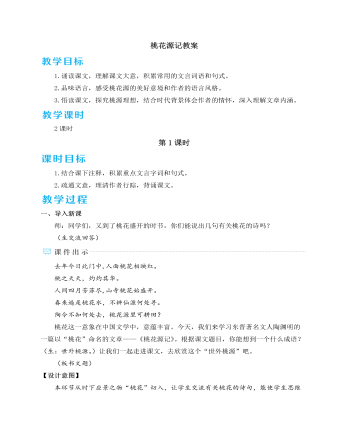
人教部编版语文八年级下册桃花源记教案
预设 不知走了多久,就在身心俱疲之际,眼前忽然出现一片仙境。清澈的溪流蜿蜒流动,与溪石相撞,发出清脆的声响。沿着溪流走上几百步,两岸仍是一片片茂密的桃花林,晴空下,桃枝交错,纷纷扰扰;桃花缤纷迷离,似红云,似粉霞。而桃林地面上则青草葱茏,就连路过的清风也沾上桃香,惹下了一场桃花雨。只见那些花瓣调皮地在空中起舞,最后或落在岸上,与青草私语,或落于溪中,随流水旅行……设问2:看到这样一片美丽而又奇特的桃花林,渔人又有什么感受呢?预设 “忽逢”一词体现了渔人的惊喜之情。“渔人甚异之,复前行,欲穷其林”,体现了渔人十分好奇,急切地想探寻桃花林的心理。(2)在朗读中感受美。(教师指导学生在朗读中感受桃林之美和渔人之惊喜。)朗读指导:“忽逢”要读出惊喜,速度稍快,“数百步”三字要强调重读,以体现桃林的范围之广。“中无杂树,芳草鲜美,落英缤纷”要以“二二”的节奏断开,但前后之间要语气贯连,读得似断实连,语速要稍慢,将一幅幅画面徐徐呈现出来,就像放电影一般,以体现渔人此刻的痴迷沉醉之情。
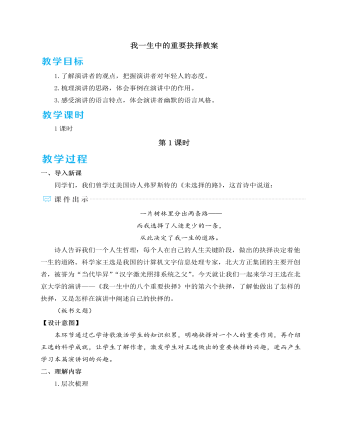
人教部编版语文八年级下册小石潭记教案
结束语:怀才不遇的柳宗元,他像陶渊明一样“采菊东篱下,悠然见南山”,也像吴均一样“从流飘荡,任意东西”,面对“凄神寒骨,悄怆幽邃”的小石潭,他选择“记之而去”,这其实体现的是柳宗元的人生态度。他有着高贵的灵魂,选择了自己想要的人生。在柳宗元身上,我们看到了古代圣贤在人生困顿之时坚守的济世情怀,那么我们又该如何实现人生的价值呢?这是我们要认真思考的一个人生命题。【设计意图】本环节通过抓住景物特点,帮助学生揣摩分析作者情感,体会寓情于景的特点。并通过插入作者的相关背景,引导学生准确把握作者心情由乐而悲的缘由,依据文本,具体深入而非概念化地理解作者“悲”的由来。三、存储总结1.师小结山水游记的写法(1)合理安排写景方法。如移步换景、定点观察等。(2)细致生动地描绘游览过程中所看到的主要景物,突出其特点。(3)巧妙地运用多种修辞手法、描写手法,使语言生动优美,富于变化。(4)融情于景,情景交融。2.推荐阅读课后阅读“永州八记”中的其他篇目。
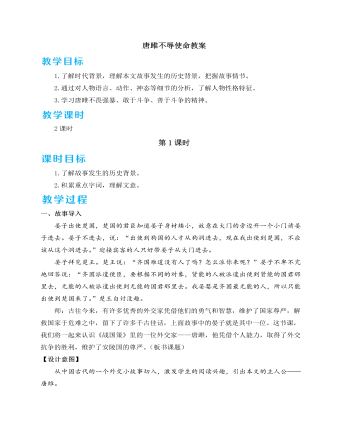
人教部编版语文九年级下册唐雎不辱使命教案
预设 对比与映衬、渲染与烘托。由于文章始终是在人物对话中展开的,人物语言和行为遵循“刺激—反应”模式平行而下,自然形成了对比,造成了映衬互见的效果。如围绕易地问题,就有秦王的欲求与安陵君的坚守,有秦王的无理狡辩与唐雎的据理抗争;在意志较量方面,则有“天子之怒”与“布衣之怒”的对垒。秦王所说的“天子之怒”,唐雎的“未尝闻”;唐雎所说的“布衣之怒”,秦王归之于“免冠徒跣,以头抢地”。一个拒绝回答,非常傲气;一个丑化描述,极为轻蔑。这样,人物形象对比鲜明,相互衬托,将一场正义与非正义的较量真实而生动地展现出来。作者为了追求夸张、强化的效果,多借助人物语言渲染气势、烘托气氛,增强故事的“现场感”。如秦王说“灭韩亡魏”,目的是从气势上压倒对手;唐雎罗列刺客的壮举,也表明了血拼到底的气概。秦王先说“灭韩亡魏”,气势夺人;后说“韩、魏灭亡”,辞格已卑。这些生动的描写,极大地凸显了人物性格。
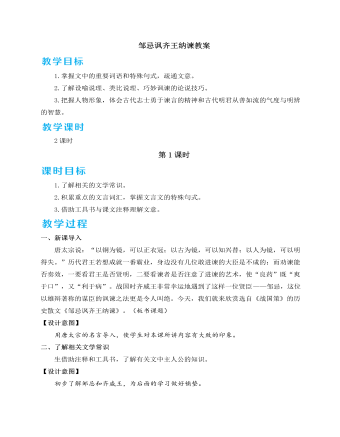
人教部编版语文九年级下册邹忌讽齐王纳谏教案
第二,《战国策》描写人物的性格和活动更加具体细致,也就更显得生动活泼。《左传》描写人物,大抵是简笔勾勒。第三,《战国策》所记的策士说辞,常常引用生动的寓言故事,这也是以文学手段帮助说理的方法。这些寓言,形象鲜明,寓意深刻,又浅显易懂,独立地看也是中国文学宝库中的璀璨明珠。疑难探究除了高超的语言艺术,邹忌劝谏成功还有哪些重要因素?除了高超的语言艺术,邹忌能劝谏成功,还有其他重要的因素。比如:这也与邹忌善于思考、分析的个性和他的担当、责任意识相关。邹忌关心国家大事,一心想寻找恰当时机劝谏齐王。他在生活中经历了“比美”经历,能够深入思考、分析,体察各人的情状心理,并敏锐地由个人体验联系到国家大事,想到齐王所受之蔽,于是果断地进行劝谏。这也离不开齐王广开言路的胸襟和果断行事的理政智慧。齐王听了邹忌的劝谏,马上“下令”,并且分上、中、下三种不同层面赏赐,立刻实施,表现出一位贤明君主的特点。
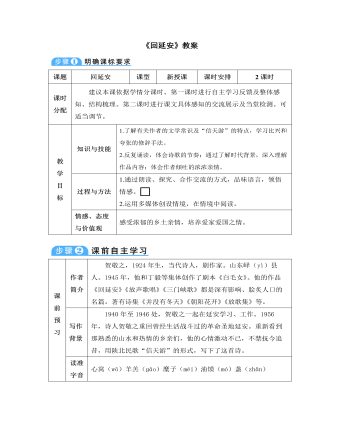
部编版语文八年级下册《回延安》教案
【初读课文,整体感知】1.诗歌共分为五小节,这五小节分别写了什么内容?第一小节:阔别十年重回延安;第二小节:追忆当年战斗生活;第三小节:亲人相见话延安;第四小节:喜看延安今繁华;第五小节:颂延安光辉历史。2.试想想诗人写作这首诗抒发思想情感的线索是什么?讨论、明确:全诗以诗人离别10年后重返延安的所见所闻所想为线索。【细读课文,仔细品味】1.作者在第一节中是怎样通过一系列动词表现情感的?“抓”“贴”等逼真的动作,表现了诗人回到延安时的激动情景。“双手搂定宝塔山”的“搂”字,写尽了作者对延安的怀念。“唱”“笑”“招”具有拟人的色彩,渲染了欢乐的气氛。最后一个“扑”字,强烈、准确地表达出作者的想念。2.第二节中,“二十里铺送过柳林铺迎,分别十年又回家中”在结构上有什么作用?





